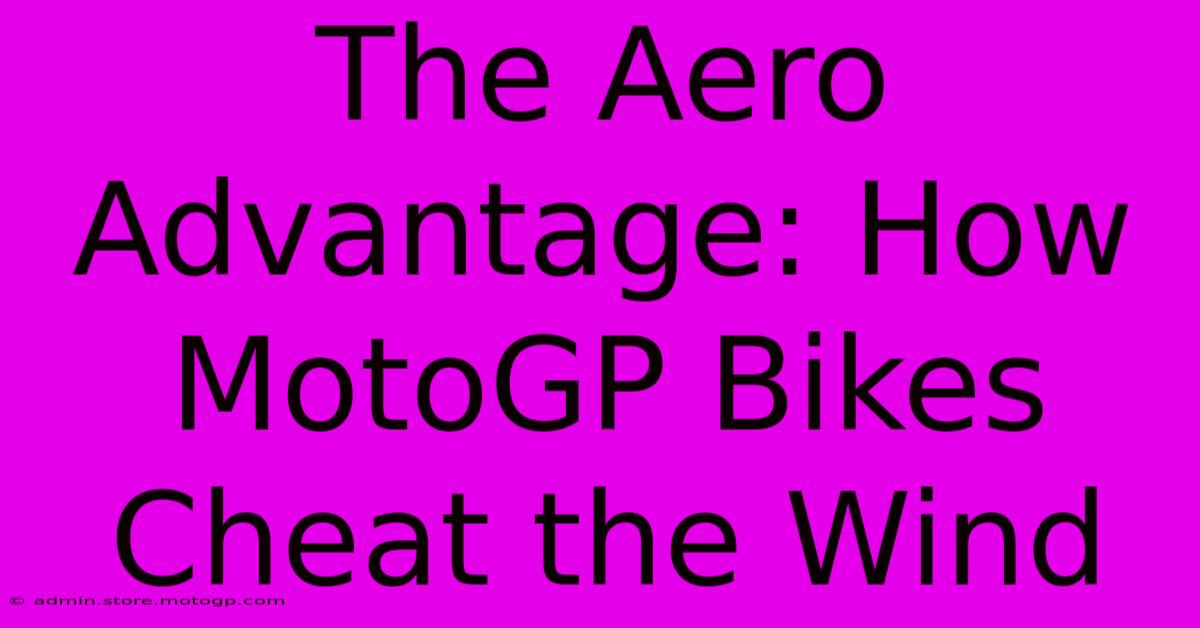The Aero Advantage: How MotoGP Bikes Cheat The Wind

Table of Contents
The Aero Advantage: How MotoGP Bikes Cheat the Wind
MotoGP. The pinnacle of motorcycle racing. A spectacle of speed, skill, and technological innovation. But beyond the breathtaking speeds and daring overtakes lies a silent battle – the fight against the wind. And in this battle, aerodynamics plays a crucial role. This article delves into the fascinating world of MotoGP aero, explaining how these machines "cheat" the wind to achieve a crucial competitive edge.
Understanding the Wind's Impact
At MotoGP speeds, aerodynamic drag becomes a significant force. Think of it as an invisible brake, constantly working against the bike's forward momentum. Overcoming this drag consumes valuable horsepower, impacting acceleration and top speed. This is where aerodynamic advancements come into play. Teams invest heavily in wind tunnel testing and computational fluid dynamics (CFD) to minimize drag and maximize downforce.
Drag Reduction: The Silent Speed Boost
Reducing drag is paramount. Every gram of drag reduction translates to increased speed and improved lap times. MotoGP bikes employ various techniques to achieve this:
-
Streamlined Fairings: The fairings, the bodywork surrounding the engine and rider, are meticulously designed to slice through the air with minimal resistance. Every curve, every angle, is carefully optimized to minimize turbulence. The evolution of these fairings is a testament to continuous aerodynamic refinement.
-
Winglets and Aerodynamic Appendages: While initially controversial, winglets and other aerodynamic appendages have become ubiquitous. These small wings generate downforce, improving stability at high speeds, especially during braking and cornering. The design and placement of these components are crucial for optimizing their effectiveness and avoiding undesirable effects.
-
Rider Positioning: Even the rider's posture plays a role in minimizing drag. A tucked riding position minimizes the frontal area exposed to the wind, resulting in a significant reduction in drag. This subtle detail can make a surprising difference in overall performance.
Downforce: The Grip Advantage
While reducing drag is essential, generating downforce is equally crucial. Downforce presses the bike onto the track, enhancing grip and allowing for faster cornering speeds. This is where the "cheating the wind" aspect comes in – using the wind to improve traction.
Generating Downforce: Wings and More
Generating downforce relies heavily on strategically placed aerodynamic surfaces:
-
Advanced Wing Designs: MotoGP wings are not merely for show; they are sophisticated aerodynamic devices, often incorporating complex profiles and adjustments to optimize downforce depending on the track characteristics. Teams constantly refine their designs, pushing the boundaries of aerodynamic performance.
-
Underbody Aerodynamics: The underside of the bike also plays a crucial role. Careful shaping and channeling of airflow underneath the bike can significantly contribute to downforce generation. This often involves complex designs that manage airflow effectively.
-
Bodywork Integration: The seamless integration of the various aerodynamic components is key. Turbulence created by one component can negatively affect the performance of another. Therefore, the entire aerodynamic package must work in harmony to achieve optimal results.
The Ongoing Evolution of MotoGP Aerodynamics
The pursuit of aerodynamic perfection in MotoGP is a continuous process. Teams constantly experiment with new materials, designs, and simulation techniques to push the boundaries of performance. The regulations themselves often play a role, influencing design trends and prompting innovative solutions. The battle against the wind is a never-ending one, shaping the very nature of the sport.
In conclusion, the aerodynamic advantage in MotoGP is not merely about speed; it's about control, stability, and ultimately, winning. The complex interplay of drag reduction and downforce generation showcases the ingenuity and technological prowess driving this exhilarating motorsport. The constant evolution of aerodynamic solutions ensures that the fight against the wind will remain a key factor determining success in MotoGP for years to come.

Thank you for visiting our website wich cover about The Aero Advantage: How MotoGP Bikes Cheat The Wind. We hope the information provided has been useful to you. Feel free to contact us if you have any questions or need further assistance. See you next time and dont miss to bookmark.
Featured Posts
-
Race Proven Performance Racing Motorcycles
Feb 19, 2025
-
Experience Moto Gp Like Never Before With Tnt
Feb 19, 2025
-
Will Sprint Races Make Moto Gp More Popular
Feb 19, 2025
-
Austin F1 Qualifying Live Stream And Highlights
Feb 19, 2025
-
Moto2 Motorcycles Experience The Difference
Feb 19, 2025
